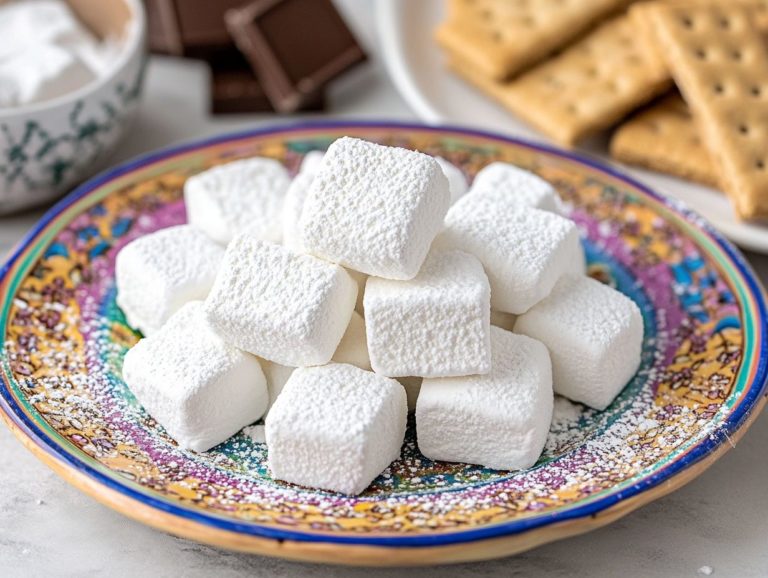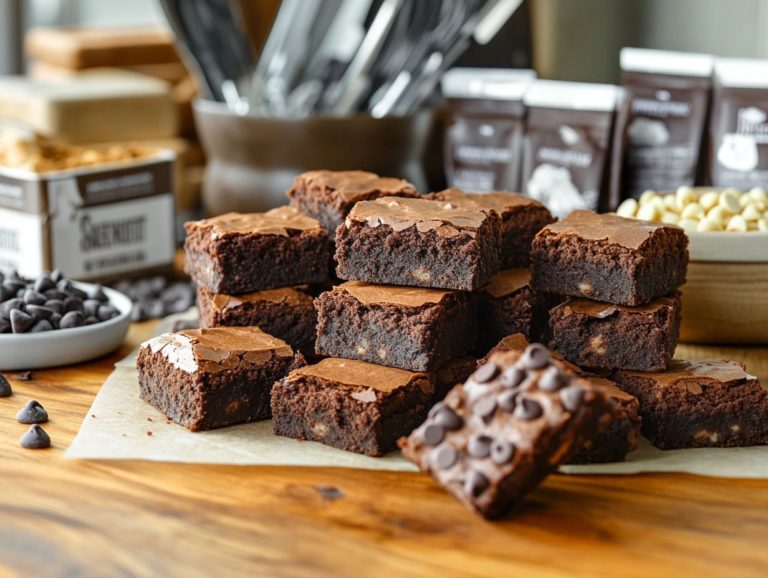Easy Gluten-Free Scones for Breakfast
Craving a delightful breakfast treat that satisfies your palate while being gluten-free? Your search ends here!
This article will walk you through the essential ingredients required to create the perfect gluten-free scones, ensuring that you don t miss out on this classic indulgence.
From expertly mixing the dry ingredients to exploring creative flavor variations like blueberry and chocolate chip, you ll discover all the tips necessary for a truly scrumptious start to your day.
Prepare to elevate your breakfast experience!
Contents
- Key Takeaways:
- What Are The Ingredients For Gluten-Free Scones?
- 3. Salt
- 4. Butter
- 5. Milk
- How To Make Gluten-Free Scones?
- Baking Gluten-Free Scones
- 1. Preheat The Oven
- 2. Mix Dry Ingredients
- 3. Cut In Butter
- 4. Add Milk
- 5. Knead The Dough
- 6. Cut And Bake The Scones
- What Are Some Variations Of Gluten-Free Scones?
- 1. Blueberry Scones
- 2. Chocolate Chip Scones
- 3. Lemon Poppy Seed Scones
- 4. Cranberry Orange Scones
- Frequently Asked Questions
- Can I make gluten-free scones for breakfast without any special ingredients?
- Are gluten-free scones for breakfast difficult to make?
- Can I substitute regular flour for gluten-free flour in the scone recipe?
- How do I know when my gluten-free scones for breakfast are done baking? Here are some baking tips:
- Can I freeze the scone dough to make ahead of time?
- What are some gluten-free mix-ins I can add to my scones for breakfast?
Key Takeaways:
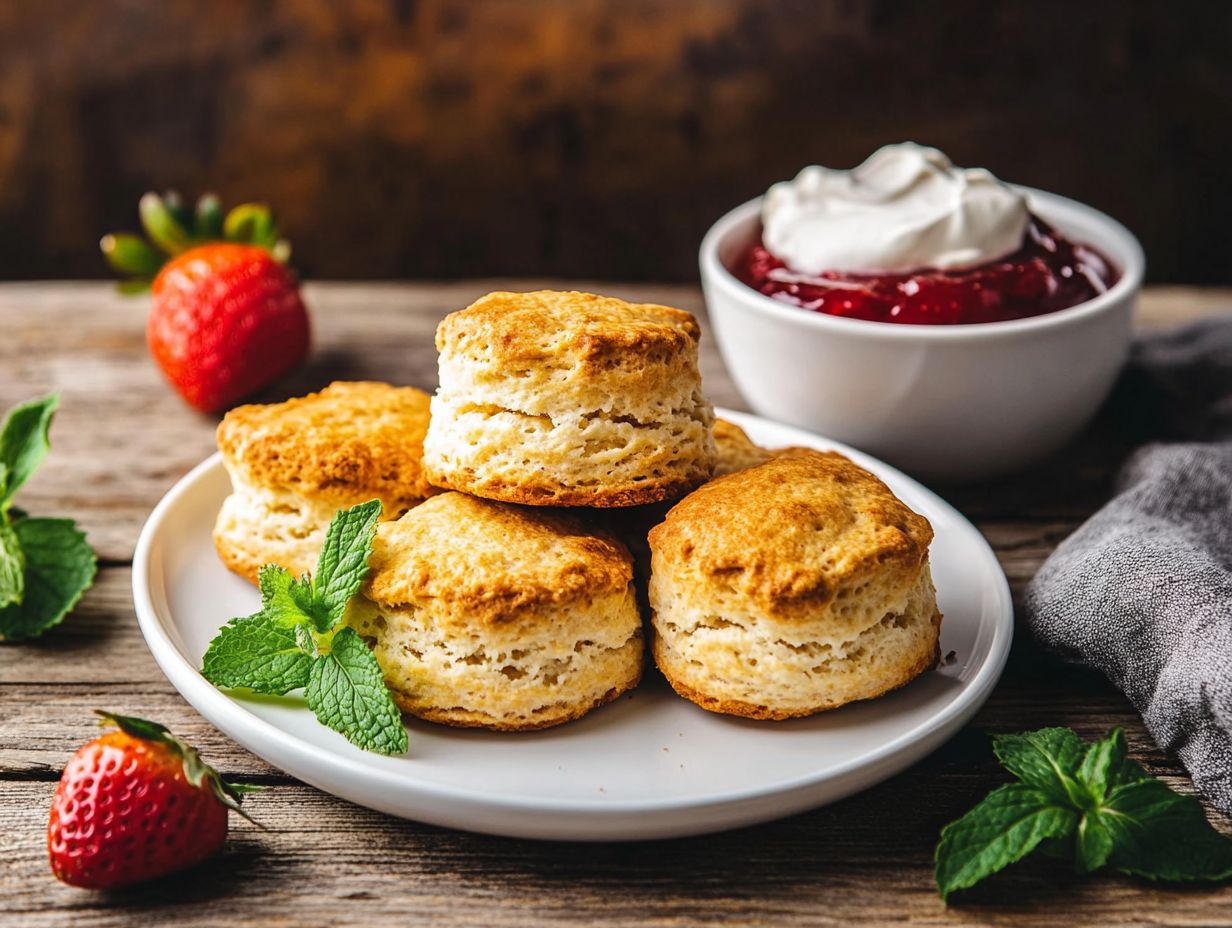
- Use gluten-free flour, baking powder, salt, butter, and milk as the main ingredients to make delicious gluten-free scones for breakfast.
- Preheat the oven, mix dry ingredients, cut in butter, add milk, knead the dough, cut, and bake the scones for a perfect gluten-free breakfast treat.
- Add your favorite ingredients such as blueberries, chocolate chips, lemon and poppy seeds, or cranberries and oranges to create delicious variations of gluten-free scones for a flavorful breakfast.
What Are The Ingredients For Gluten-Free Scones?
To create delicious gluten-free scones that are light and moist, you must prioritize high-quality ingredients that cater to dietary restrictions while enhancing flavor and texture.
Start with gluten-free flour, which guarantees that your scones are safe for those with gluten sensitivities. Don t forget the baking powder; it s crucial for achieving that perfect rise and delightful scone texture!
Fresh-picked fruits like white peaches or blueberries can elevate your scones with a burst of flavor. Ingredients like butter and yogurt contribute moisture and richness to the dough.
This way, you ll have a breakfast recipe that everyone will savor!
1. Gluten-Free Flour
Gluten-free flour serves as the cornerstone of any gluten-free scone recipe. It replaces traditional all-purpose flour and allows you to indulge in delightful pastries without worry.
Selecting the right type of gluten-free flour dramatically affects the texture and flavor of your scones. For example, almond flour contributes a moist, slightly nutty flavor, while coconut flour imparts a delicate sweetness and a unique texture that can elevate your baked goods.
Experimenting with different flour blends can yield the best results. Mixing almond flour with tapioca flour, for instance, creates a light, airy quality that closely mimics traditional scones. Renowned gluten-free brands like Bob’s Red Mill and King Arthur Baking offer a variety of blends designed to make your baking experience seamless!
Just remember, when using these alternative flours, adjusting the liquid content is crucial for achieving that perfect dough!
2. Baking Powder
Baking powder serves as an essential leavening agent for crafting light and airy gluten-free scones. It ensures they rise beautifully and boast a delightful texture!
Understanding the science behind baking powder and baking soda can elevate your baking skills, especially in the realm of gluten-free recipes. Baking powder includes both an acid and a base, allowing it to spring into action with just moisture. Conversely, baking soda requires an acidic ingredient to unlock its leavening potential.
In gluten-free baking, where traditional flours are replaced, selecting the right leavening agents becomes crucial to mimic the structure that gluten typically provides. When you choose egg substitutes like applesauce or flaxseed meal, striking the right balance of moisture and binding ability can significantly influence the final outcome of your scones.
Experimenting with different combinations is essential to discover which substitutions yield the best results for achieving that ideal rise and texture!
Ready to bake some delightful scones? Let s get started!
3. Salt
Salt is an essential ingredient in baking, even in gluten-free recipes. It enhances the flavors of your scones and balances out the sweetness.
Its presence elevates the overall taste profile. This ensures that sweetness does not overpower the other flavors. Salt also controls yeast activity. This is crucial for achieving the ideal texture and rise in your baked goods.
For gluten-free scone recipes, the recommended amount of salt typically falls between a quarter to half a teaspoon per cup of flour. This can vary depending on whether you re making sweet or savory scones. If you re leaning toward sweeter scones, stick to the lower end of this range to help preserve their sweetness. Savory scones can benefit from a slightly higher amount of salt to enhance the flavors of herbs and cheese.
Don t hesitate to experiment within these guidelines! You might just stumble upon a delightful flavor combination.
4. Butter
Butter imparts a luxurious richness and depth of flavor to gluten-free scones. It ensures a moist crumb and elevates your overall culinary experience.
Its distinct qualities are essential for achieving that tender texture synonymous with perfect scones. When baking, using butter requires attention to detail, particularly during the process of ‘cutting in‘ the fat. This technique involves evenly distributing the butter throughout the flour mixture without allowing it to fully melt. This step is crucial for creating delightful pockets of air that retain moisture during baking, resulting in a wonderfully fluffy interior.
If you’re lactose intolerant or prefer a dairy-free alternative, options like coconut oil or vegan butters can be seamlessly substituted. Just remember, you may need to adjust temperature and texture to preserve that ideal scone consistency.
5. Milk
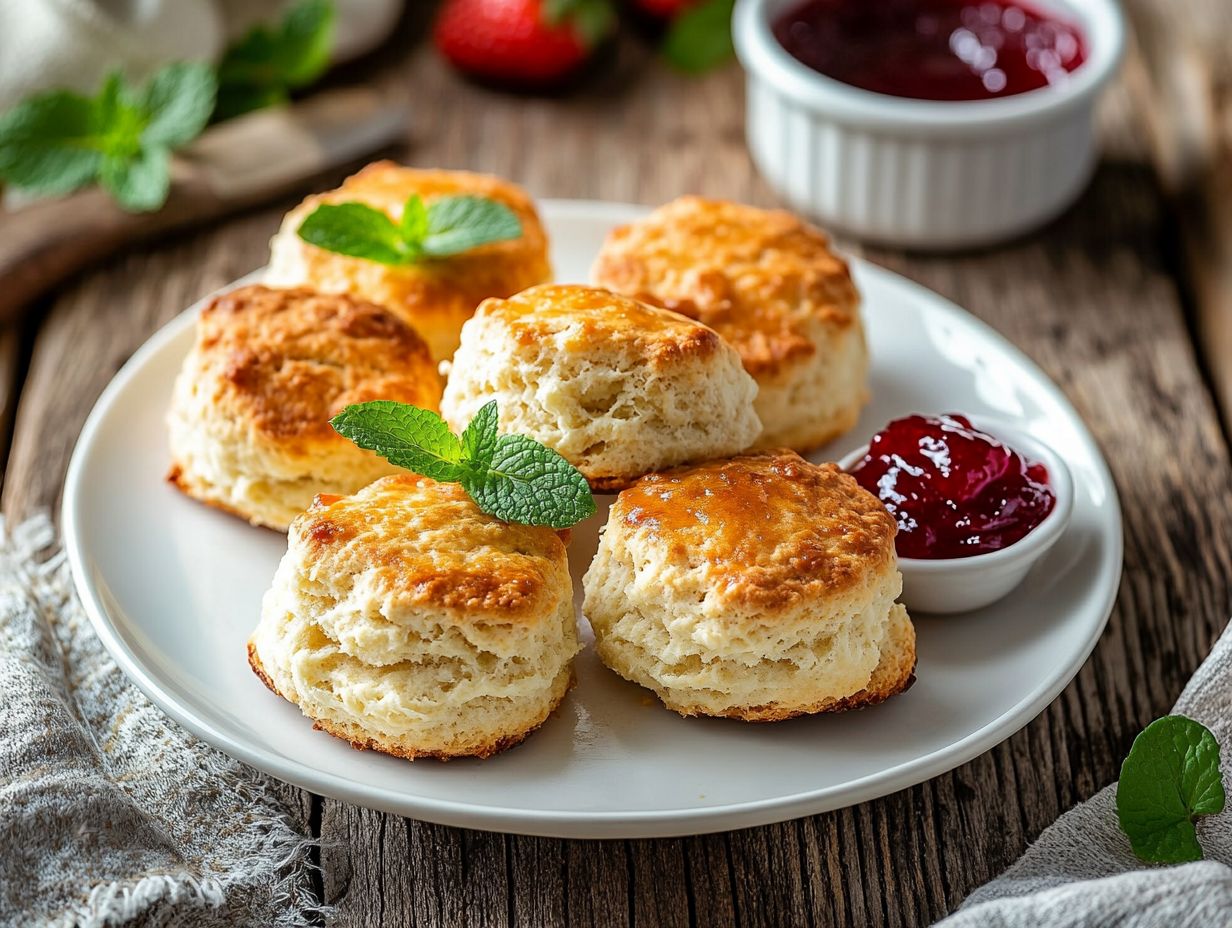
Milk, or a dairy alternative, plays a vital role in gluten-free scone recipes. It hydrates the dough and ensures a tender, moist texture.
Try different types of milk, like almond or coconut. They add unique flavors and richness that regular dairy can t match. Almond milk, with its subtle nuttiness, might enhance the sweetness of your scones. Coconut milk introduces a delightful tropical twist, making it an ideal choice for a summer brunch. Yogurt is another fantastic option; it adds creaminess and a slight tang that elevates your baked goods.
Choose unsweetened or low-fat versions to stay healthy without sacrificing flavor! Your taste buds will thank you!
When substituting dairy, adjust the liquid quantities accordingly. Start with slightly less than the recipe specifies and add gradually until you achieve the desired dough consistency.
How To Make Gluten-Free Scones?
Creating gluten-free scones at home is a delightful and uncomplicated endeavor. It s perfect for engaging children in the kitchen while crafting a delicious treat for breakfast or afternoon tea.
The journey begins with preheating the oven and gathering your ingredients. Each step brings you closer to that light, moist scone texture that everyone loves.
With a straightforward recipe, embark on a flavorful exploration. Experiment with options like delightful cinnamon swirl or vibrant fresh blueberries. Transform the baking experience into a fun and rewarding culinary adventure!
Get started today and enjoy a delightful treat that everyone will love!
Baking Gluten-Free Scones
1. Preheat The Oven
Preheating the oven is an essential first step in baking gluten-free scones. It creates an even temperature that encourages proper rising.
Set your oven to the ideal temperature of 400 F (200 C) to achieve that coveted golden crust while keeping your scones soft and fluffy inside. This precise heat is crucial for cooking the gluten-free flour correctly, preventing your scones from becoming dense and heavy.
Preparing your baking tray thoughtfully makes a big difference. Consider lining it with parchment paper or using a silicone mat; these techniques prevent sticking and promote uniform baking by allowing air to circulate around the scones.
The result? A delightful texture that everyone will savor and appreciate. Get ready to enjoy the most delicious scones ever!
2. Mix Dry Ingredients
To achieve perfect gluten-free scones, start by thoroughly mixing your dry ingredients, which include gluten-free flour, baking powder, and a pinch of salt. This step ensures that the leavening agents, like baking powder and baking soda, are evenly distributed throughout the mixture.
When these ingredients are well incorporated, you ll enjoy consistent rising during baking, preventing any unwanted dense spots in your scones. Sifting the dry ingredients together helps break up clumps and introduces air into the mix, making it lighter. Using a whisk or a fork works wonders for blending and ensuring everything is thoroughly combined.
This meticulous attention to detail will reward you with fluffy, delicious scones that everyone will savor.
3. Cut In Butter
Cutting in butter is a technique that transforms your making scones process, delivering that flaky and tender texture you desire for gluten-free scones.
This method requires you to integrate cold butter into your dry ingredients until the mixture resembles a coarse meal. This step is critical for achieving that light, airy scone you crave. A pastry cutter or a fork works well, but some bakers prefer using their fingertips to minimize warmth transfer to the butter.
Work quickly and keep the butter chilled; warmer butter can lead to denser scones, which is not what you want. When the butter is firm but not solid, it incorporates perfectly into the flour, allowing steam to develop during baking and resulting in those delightful, flaky layers.
4. Add Milk
After mixing the dry ingredients and cutting in the butter, it’s time to introduce the milk or almond milk if you prefer. This step hydrates the dough and activates important leavening agents.
Choosing either milk or yogurt can elevate the moisture content and flavor profile of your dough. Milk offers luxurious creaminess, while yogurt adds a delightful hint of tanginess. You can also experiment with different yogurt flavors for a unique twist. Start with around 1/4 cup and gradually increase it based on how your dough feels.
If the dough seems too dry or crumbly, just a splash more liquid should remedy the situation. Keep an eye on the consistency; your dough should be smooth and slightly tacky without becoming overly sticky. Achieving this balance is crucial for ensuring a tender crumb in the final product. Get ready to enjoy the most delicious scones ever!
5. Knead The Dough

Kneading the dough lightly is vital for crafting gluten-free scones, as it brings together the ingredients without overworking the delicate gluten-free flour.
Striking the right balance during this process is essential; too much kneading leads to a dense and gummy texture, while too little results in scones that are crumbly and dry. The secret lies in gently folding and pressing the dough until it’s just combined this technique ensures the ingredients meld seamlessly without triggering any unwanted gluten formation, which can change the texture of your scones.
To achieve a moist crumb while maintaining structure, incorporating ingredients like yogurt or milk or even almond milk or honey syrup is highly beneficial. Chilling the dough before baking helps set the desired form. Remember, using a light touch when shaping or cutting the scones encourages the perfect rise, resulting in a tender and satisfying treat for the whole family.
6. Cut And Bake The Scones
Once your dough is ready, it s essential to cut and bake the scones with precision to ensure they rise beautifully and develop that coveted golden-brown crust.
To achieve optimal results, aim for uniform shapes, whether you prefer triangles or rounds. Not only do these shapes look appealing, but they also bake evenly. Using a sharp knife or a round cutter will help you maintain clean edges, reducing any spreading during the baking process.
When you arrange them on a baking tray, be sure to leave enough space between each scone to allow for expansion; this little detail will prevent them from merging together. Remember to preheat the oven to the required temperature as per the recipe guide.
Check them after 15-20 minutes to catch the perfect bake! A quick tap on the bottom should yield a hollow sound, signaling that they re perfectly baked. Serving them warm will maximize flavor and texture, ensuring an irresistible treat for everyone. For gluten-free baking, following these baking tips is essential for success.
What Are Some Variations Of Gluten-Free Scones?
Exploring the array of flavor options for gluten-free scones can elevate your baking experience to new heights, presenting you with delightful variations that accommodate a spectrum of tastes and preferences.
Imagine indulging in classic blueberry and chocolate chip scones, or perhaps trying something more adventurous like cinnamon swirl and lemon poppy seed there s a delectable option for every palate.
These variations not only preserve the moist crumb and tender texture reminiscent of traditional scones but also offer a chance to embrace healthier alternatives, ensuring that everyone can savor their favorite pastries as a delightful dessert or a quick breakfast treat.
1. Blueberry Scones
Blueberry scones present a delightful choice for those in search of a healthier dessert, combining the sweetness of fresh blueberries with a soft, moist texture. This breakfast recipe is both nutritious and delicious.
To incorporate those luscious blueberries into the scone dough, gently fold them in after mixing your dry ingredients, just before introducing the wet ones. This technique ensures an even distribution while preserving the integrity of the berries, allowing their juicy bursts to shine through. You ll also want to slightly reduce the amount of liquid ingredients, as blueberries contribute their own moisture to the dough.
Not only do these vibrant berries elevate the flavor profile of your scones, but they also offer a wealth of health benefits. Blueberries not only enhance the flavor but are also packed with antioxidants, vitamins, and fiber. They can improve heart health and boost brain function, imparting a refreshing tang that harmonizes beautifully with the buttery richness of the scones. Including fresh-picked blueberries can make a noticeable difference in flavor.
2. Chocolate Chip Scones
Chocolate chip scones are a delightful treat that effortlessly marries the indulgence of rich chocolate chips with a simple gluten-free recipe everyone can savor. This gluten-free success story is perfect for any occasion.
To craft these exquisite scones, consider how to incorporate the chocolate chips into the dough. Choose high-quality chocolate chips, such as semi-sweet for classic sweetness or dark chocolate for a deeper flavor. Your choice will profoundly influence the final outcome.
This is an easy recipe that can get the kids involved in home baking, making it fun for the whole family.
For those adhering to a dairy-free lifestyle, feel free to substitute with dairy-free chocolate options. Just adjust the sugar content accordingly, especially when using sweeter varieties. A little tip: sprinkle a few extra chocolate chips on top before baking to elevate the visual appeal and guarantee delightful bursts of chocolate in every bite. Consider using fresh fruit like white peaches or peaches for an added layer of flavor.
3. Lemon Poppy Seed Scones
Lemon poppy seed scones offer a delightful twist on traditional recipes. The zesty lemon and crunchy poppy seeds enhance the flavor in a truly refreshing way, making this a prime example of gluten-free baking at its finest.
To mix the bright lemon zest into your scone dough, simply reach for a microplane. Grate the outer yellow layer of the lemon, taking care to avoid the bitter white pith lurking underneath. This vibrant zest should be mixed with the dry ingredients, allowing its aromatic oils to meld with the flour and create an inviting base.
When it s time to add the poppy seeds, gently fold them into the dough once it has reached a slightly shaggy consistency. This technique ensures an even distribution without overworking the dough, preserving the perfect texture and moist crumb.
The unique combination of tart lemon and nutty poppy seeds not only elevates the scones but also pairs delightfully with creamy yogurt. This adds a luxurious touch to your breakfast or afternoon tea spread, transforming an ordinary moment into something truly special. Try these scones for your next breakfast or tea, and impress your family!
4. Cranberry Orange Scones
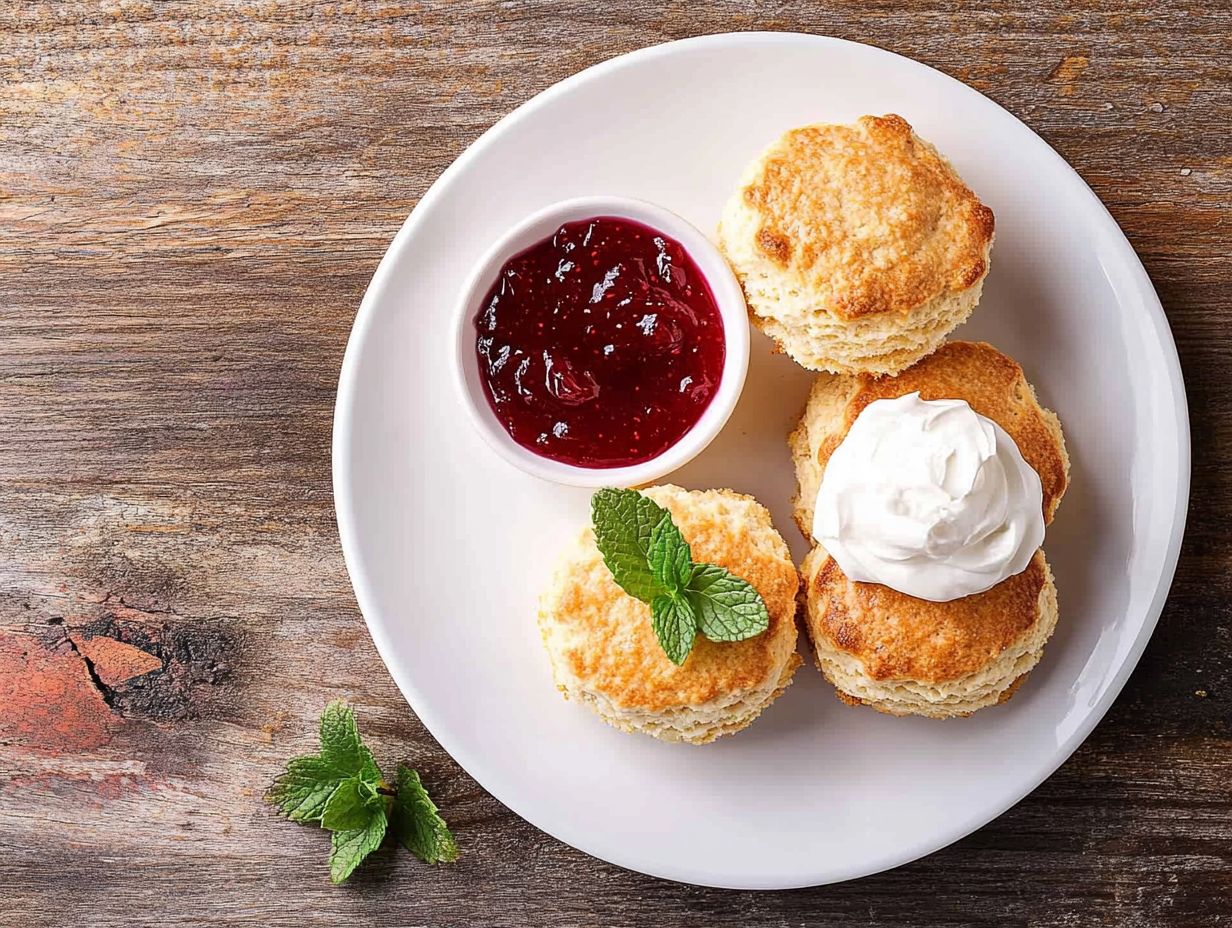
Cranberry orange scones beautifully meld the tartness of cranberries with the bright notes of orange zest, creating a delightful balance perfect for breakfast or an afternoon tea. This combination is a favorite in many gluten-free options.
When making these exquisite treats, you can use either fresh or dried cranberries, each contributing its unique texture and flavor profile. Fresh cranberries provide a juicy burst, while dried cranberries add a chewy sweetness that enhances the overall experience. This recipe guide will walk you through all the steps.
The inclusion of orange zest not only elevates the scone’s flavor but also infuses it with a refreshing aroma that evokes warmth and comfort. If you’re searching for healthier alternatives, consider substituting traditional sugar with honey syrup. This naturally sweetened option beautifully complements the other flavors, allowing those delectable ingredients to shine through without compromising your health. This makes them an excellent choice for healthy alternatives.
Frequently Asked Questions
Here are some baking tips and kitchen essentials to ensure your gluten-free baking is a success.
Can I make gluten-free scones for breakfast without any special ingredients?
Yes, you can make gluten-free scones for breakfast using common ingredients such as gluten-free flour, baking powder, salt, butter, milk, and egg. Enhance the flavor with lemon zest, cinnamon, or blueberries.
Are gluten-free scones for breakfast difficult to make?
No, with the right recipe and ingredients, gluten-free scones for breakfast can be just as easy to make as traditional scones. Follow a gluten free guide to ensure gluten free success.
Can I substitute regular flour for gluten-free flour in the scone recipe?
Yes, you can substitute all-purpose gluten
Yes, you can substitute regular flour for gluten-free flour in most scone recipes. However, the texture and taste may be slightly different. Using a combination of gluten-free flour with baking powder and baking soda can help achieve a similar texture.
How do I know when my gluten-free scones for breakfast are done baking? Here are some baking tips:
Gluten-free scones may take slightly longer to bake than traditional scones. You can test if they are done by inserting a toothpick into the center – if it comes out clean, they are ready. For a light moist texture, make sure to use gluten free flour and include some creamy yogurt in your recipe.
Can I freeze the scone dough to make ahead of time?
Yes, you can freeze the scone dough before baking. When you’re ready to make them, simply thaw the dough in the fridge overnight and then bake as directed in the recipe. This makes it an easy treat for a quick breakfast or afternoon tea.
What are some gluten-free mix-ins I can add to my scones for breakfast?
You can add various mix-ins to your gluten-free scones such as dried fruit, chocolate chips, nuts, or even savory ingredients like herbs and cheese. For a sweet cinnamon twist, try adding cinnamon swirl or butter cinnamon. Fresh blueberries and white peaches also make great choices. Get creative and experiment with different flavors for delicious pastries!




